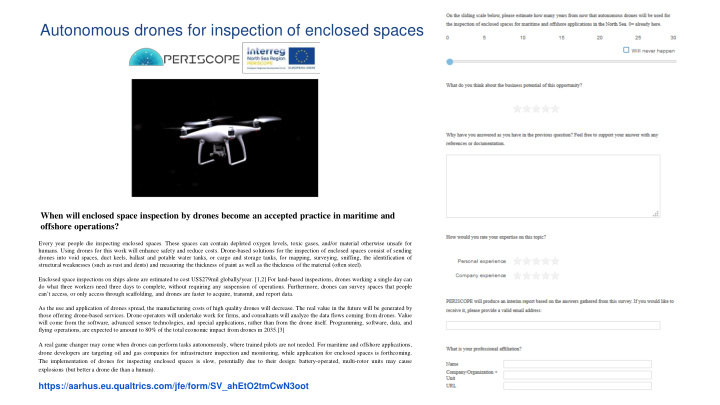



Autonomous drones for inspection of enclosed spaces When will enclosed space inspection by drones become an accepted practice in maritime and offshore operations? Every year people die inspecting enclosed spaces. These spaces can contain depleted oxygen levels, toxic gases, and/or material otherwise unsafe for humans. Using drones for this work will enhance safety and reduce costs. Drone-based solutions for the inspection of enclosed spaces consist of sending drones into void spaces, duct keels, ballast and potable water tanks, or cargo and storage tanks, for mapping, surveying, sniffing, the identification of structural weaknesses (such as rust and dents) and measuring the thickness of paint as well as the thickness of the material (often steel). Enclosed space inspections on ships alone are estimated to cost US$279mil globally/year. [1,2] For land-based inspections, drones working a single day can do what three workers need three days to complete, without requiring any suspension of operations. Furthermore, drones can survey spaces that people can’t access, or only access through scaffolding, and drones are faster to acquire, transmit, and report data. As the use and application of drones spread, the manufacturing costs of high quality drones will decrease. The real value in the future will be generated by those offering drone-based services. Drone operators will undertake work for firms, and consultants will analyze the data flows coming from drones. Value will come from the software, advanced sensor technologies, and special applications, rather than from the drone itself. Programming, software, data, and flying operations, are expected to amount to 80% of the total economic impact from drones in 2035.[3] A real game changer may come when drones can perform tasks autonomously, where trained pilots are not needed. For maritime and offshore applications, drone developers are targeting oil and gas companies for infrastructure inspection and monitoring, while application for enclosed spaces is forthcoming. The implementation of drones for inspecting enclosed spaces is slow, potentially due to their design: battery-operated, multi-rotor units may cause explosions (but better a drone die than a human). https://aarhus.eu.qualtrics.com/jfe/form/SV_ahEtO2tmCwN3oot
Time until the technology will be in application in the North Sea Answer options: scale of years from today till 2050
Business potential of the opportunity Answer options: scale from 1 to 5
Autonomous drones for inspection of enclosed spaces What’s the respondents’ opinion about the business potential? Technology Market ● “Technology is available but fragmented in the market and ● “The business potential is even higher when you needs to be customized for each application. ” consider cross-overs onshore and other branches. ” ● “They are constantly becoming safer and more versatile, ● “More and more class organization are approving these providing machines with ever more innovative and varied kind of tank surveys increasing the safety enormously. capabilities. ” more and more ship owners are convinced about this possibility. ” ● “Technology already exists in other domains. Technology is required to scale up availability of service providers and ● “First off all drone inspection needs to be rolled out in bring the relation between data and position of the drone” the areas where there is plenty of free Space around (e.g masts and legs). Drone inspection of enclosed ● “Autonomy has already existed for many years and is spaces for maritime and offshore Application will being investigated in the yachting by way of autonomous docking or sailing” become common pracsis, but not by 2022. My Guess would be by 2030. ”
Recommend
More recommend